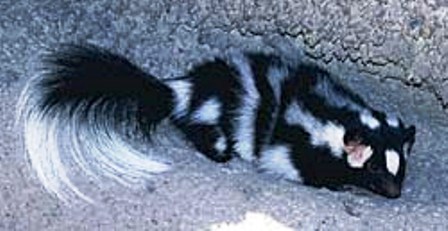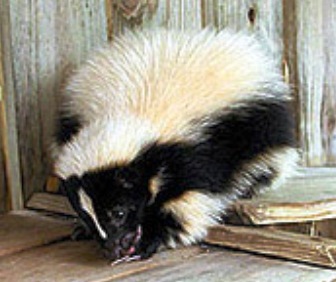Discover Florida Nature
It's time to explore the natural Florida


|
|
|
|
|
|
Florida is home to both the Eastern spotted skunk (Spilogale putorius)
and the Striped skunk (Mephitis mephitis). They occur throughout Florida
except for the Keys. Both skunk species are about the size of a house
cat with a small head, short legs, and a bushy tail. Skunks have highly
useful defense strategies, the most effective of these being a pungent
spray of oily musk from scent glands located near the anus. The spray is
effectively aimed at targets up to 15 feet away. The spray deters
predators such as foxes,
bobcats, coyotes and
domestic dogs. Their chief predator is the great horned
owl. Female skunks generally give birth to a litter of 4-7 babies in the spring. Newborns are blind and have very fine hair with the same black and white pattern as they would have as adults. When they are about six weeks old, the young follow their mother on food forays, searching for small mammals, insects, bird eggs, and amphibians, as well as roots, seeds, fruit and other plant parts. The mother and young stay together for several months, emerging from their underground burrows at night.  The
Eastern spotted skunk is a small black and white mammal about
20 inches long, including the eight inch tail, weighing about two
pounds. The Eastern spotted skunk is black with horizontal white stripes
on neck and shoulders, and irregular vertical stripes and elongated
spots on sides. This skunk also has white spots on top of it's head,
between the eyes. The fur of the Eastern Spotted Skunk is the finest and
silkiest of the skunk furs, and pelts were once considered valuable. The
Eastern spotted skunk is the only skunk that can climb trees. And, when
an enemy approaches, it can do a hand stand, point its anal glands
towards the intruder, and spray away! Faster and more agile than the
larger skunks, the Eastern Spotted Skunk is more social than other
skunks, and several individuals may share a den in winter. Highly
carnivorous, the Eastern Spotted Skunk feeds mainly on small mammals,
but also eats grubs and other insects, as well as corn, grapes, and
mulberries. Except when rearing the young, this skunk does not occupy a
particular territory, but rather moves about and dens wherever
convenient. The
Eastern spotted skunk is a small black and white mammal about
20 inches long, including the eight inch tail, weighing about two
pounds. The Eastern spotted skunk is black with horizontal white stripes
on neck and shoulders, and irregular vertical stripes and elongated
spots on sides. This skunk also has white spots on top of it's head,
between the eyes. The fur of the Eastern Spotted Skunk is the finest and
silkiest of the skunk furs, and pelts were once considered valuable. The
Eastern spotted skunk is the only skunk that can climb trees. And, when
an enemy approaches, it can do a hand stand, point its anal glands
towards the intruder, and spray away! Faster and more agile than the
larger skunks, the Eastern Spotted Skunk is more social than other
skunks, and several individuals may share a den in winter. Highly
carnivorous, the Eastern Spotted Skunk feeds mainly on small mammals,
but also eats grubs and other insects, as well as corn, grapes, and
mulberries. Except when rearing the young, this skunk does not occupy a
particular territory, but rather moves about and dens wherever
convenient.Highly carnivorous, the Eastern Spotted Skunk feeds mainly on small mammals, but also eats grubs and other insects, as well as corn, grapes, and mulberries. They may be attracted by insects commonly found in lawns, fruit trees, gardens, or wherever food scraps are kept. Eastern Spotted Skunk will den in vacant armadillo or gopher tortoise burrows (though they can dig their own) or brush piles, wood piles, areas with high grass, and similar sources of shelter.  Striped
skunks are easily recognized by their characteristic colors and
pattern. The fur is black with a white stripe that begins as a
triangular shape on the top of the head, forks into two stripes that
travel down the sides of the back, and usually merges again near the
base of the tail. Another white stripe runs from the base of the snout
between the eyes and ends on the forehead. Stripe width and length vary
with each individual. Stripes sometimes occur on the tail, but more
often the tail is composed of both black and white hairs intermixed. Striped
skunks are easily recognized by their characteristic colors and
pattern. The fur is black with a white stripe that begins as a
triangular shape on the top of the head, forks into two stripes that
travel down the sides of the back, and usually merges again near the
base of the tail. Another white stripe runs from the base of the snout
between the eyes and ends on the forehead. Stripe width and length vary
with each individual. Stripes sometimes occur on the tail, but more
often the tail is composed of both black and white hairs intermixed.Striped skunks are nocturnal, sleeping during the day in underground burrows and emerging around dusk to search for food. They use scent marking to communicate presence and reproductive state to other skunks. They also communicate visually, by raising their fur and changing posture. Skunks have a good sense of hearing, but their vision is poor. They are mostly silent, but do make a variety of sounds such as churring, hisses, and screams. The striped skunk is a true omnivore, eating a vast assortment of things including insects, small mammals, birds and their eggs, crustaceans, fruits, grasses, leaves, buds, grains, nuts, and carrion. Insects make up approximately 70% of their diet. Striped skunks often attack the nests of colonial insects, such as bees and ants. When attacking a bee hive, they wait for the angry bees to emerge from the hive, then bat them out of the air and eat them. Striped skunks are opportunistic and diet changes depending on the time of year and available resources. If you have problems with skunks you may be able to resolve the problem by simply removing the source of food attracting them. The animal may be caught in a trap, but relocating nuisance wildlife is illegal. If you catch a skunk in a trap, avoid being sprayed by slowly approaching the trapped skunk and cover the trap with a small tarp or towel. The trap must be moved very carefully without jarring the animal or frightening it by letting it see you. |
|
|
Advertise | Privacy Statement | Dog Encyclopedia | Video |Contact | Alaska Nature |
|